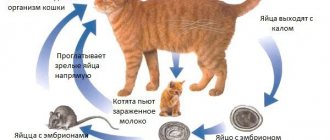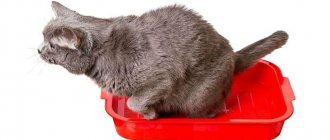15004Administration
1
Lovers of furry pets know that the problem of dealing with “surprises” that they leave in the wrong places can arise with any animal. Therefore, the primary task of the owners is the need to quickly process the scene of the “crime” in order to prevent the formation of a habit. So, the question arises, how to treat the place where the cat shits?
Even the cleanest cat can get into trouble when he walks past the litter box. This oversight is easily eliminated by cleaning. It is necessary to wash the floors so that the cat does not shit in this place anymore . In a cat that does not have psychological problems or illnesses, such an oversight occurs quite rarely.
How to punish an animal that shits in the wrong place
Most often, owners use two methods of punishment: dipping the cat's face into a puddle or hitting it.
Oddly enough, both methods ultimately turn out to be ineffective, and the animal may harbor a grudge against the owner. The result of such punishments will be puddles in unexpected places, left as revenge on the owner. Some cats may misinterpret your actions, that is, they may think that they need to relieve themselves in the exact place where they are being scolded.
Don't use brute force to punish your cat.
What is the right thing to do to convey your dissatisfaction to the animal without using force? Scold your pet verbally. As a last resort, you can lightly spank him, and then scold him verbally and scold him. By the expression on your cat's face you will see that the animal understands you. Even if this method does not work the first time, over time your pet will stop pooping in the wrong place.
If your cat systematically ignores the litter box, try moving it, along with its bed, toys, and litter box, into a small room, for example, in a hallway.
It is important that the cat's food and water bowls remain in another room. Take your cat out of this area only to eat.
After 1–2 days, you can gradually release the cat into other rooms. During this time, the animal must understand that it is behaving incorrectly. Since the tray will be in close proximity, the animal will most likely use it for its intended purpose.
The cat can be placed in the corridor for several days
If you cannot cope with the problem on your own, take the animal to the veterinarian, contact knowledgeable people for advice (cat breeders, write on thematic forums). Stopping a cat from pooping in the wrong place is a long process that requires an understanding of cat psychology and patience on the part of the owners. Ultimately, you will be able to teach your pet to behave correctly, and communication with him will give you many pleasant moments.
If a kitten shits
A kitten that goes to the toilet in a place other than where it is supposed to is a special case. As a rule, it must be taught this by its mother or another adult cat. However, in practice this does not always happen. If a kitten is orphaned early or thrown out into the street by cruel owners, there is simply no one to teach it proper behavior. Even if the baby is lucky and has a recently whelped dog looking after him, she will not be able to “explain” to him how to use the litter box. The owner will have to deal with this himself. Fortunately, kittens very quickly understand what they want from them, and after being caught in time two or three times and taken to the potty, they decide that digging into the litter is much more interesting than scraping slippery parquet floors or cold tiles.
Place your baby in the litter box immediately after he has eaten or woken up. If everything went well, be sure to praise your pet. You can tell the rest of the family about his successes. Rest assured, your little pet understands perfectly well what you are talking about, especially if you don’t forget to back up your praise with a portion of treats.
If you have a very young kitten, do not let him explore all the rooms on the first day. It’s easy to get lost in a huge (by the standards of a tiny animal) house. What if he gets a tummy ache while traveling and there’s no cozy litter box nearby? In a few days, your mustachioed pet will stop hiding in the sofa at every rustle, get used to your voice, remember where his bowl and bowl of water are, learn to confidently use the litter box, and, by the way, will grow up a little. Then it will be possible to gradually introduce him to other rooms in the house.
By following these simple rules, you will quickly train your pet to use the litter box. If, nevertheless, a certain incident happens from time to time, do not scold the baby under any circumstances! Perhaps he is not feeling well. Many kittens, and adult cats too, when they have an upset stomach, prefer to poop on the floor or in a tray without litter. In this case, it is enough to adjust the pet’s diet - and the problem will be solved.
Folk remedies
In order to ensure that your cat is weaned from bad habits, regular preventive maintenance should be carried out.
The cat litter box should be placed in a quiet and secluded place.
The animal's nutrition must be complete. Water - in sufficient quantity, without restrictions. This will avoid problems with the urinary system. Regular deworming is also required.
If a problem does arise, then it should be solved quickly, but carefully - you cannot shout at the cat or hit it, as many animals will get scared and perceive this as a manifestation of aggression on the part of humans.
Using bleach
It is not recommended to use bleach, as it only masks the odor for a while. You can also “mark” places where the cat is not allowed to go, using double-sided adhesive tape (scotch tape) for this purpose - this will help the cat understand that it is forbidden to write here.
If nothing helps and the cat continues to pee in the wrong place, you can use special medications that correct behavior, since such violations may be associated with seasonal disruptions.
What not to do
Remember: being aggressive towards an animal is a surefire way to achieve nothing. So be patient. Your cat should feel safe in your company. Try not to show signs of impatience so as not to frighten the animal, but at the same time try to show him who is boss.
So, what should she do?
- Yell at the cat;
- drag to the tray;
- poking one's muzzle into feces.
At best, the response to such actions will be an angry hiss. At worst, the animal will become embittered and begin to deliberately throw “mines” at you.
If you see that an animal is starting to settle in the wrong place, try not to scare it away. A frightened cat may start to run away, as a result of which not only will you not achieve any benefit from the educational measures taken, but you will also be cleaning up feces throughout the apartment. The only correct step is to quickly but carefully grab the cat and transport it to the litter box before it has time to come to its senses.
If you have encouraged your cat to go to the toilet correctly with treats, you should not suddenly refuse them. Otherwise, the cat may take up the old habit, deciding that there is no point in going to the litter box. Gradually reduce the portion of food, and then switch to simple stroking and gentle words.
Under no circumstances should you throw an offending cat out into the street!! This can only alienate you, as a result of which the animal will become even more disobedient and obstinate. For the same reason, there is no need to deprive the animal of water and lock it in a separate room.
Also pay attention to where exactly the tray is located. It's not worth putting it:
- in a noisy crowded place;
- in open space;
- in a cold place.
If your cat finally agrees to use the litter box, do not under any circumstances replace the litter with a cheaper alternative, as the animal may refuse to use it again after seeing an unfamiliar substance inside.
How to treat a place where a cat shits
It is worth treating with sharply odorous substances so that the smell disappears completely and the cat no longer feels it. You can put onions in the place where the cat pooped; this is the most unpleasant smell for animals. And also wipe it several times with a manganese solution, and the cat will stop peeing anywhere.
Spray
If you can’t wean it off in other ways so that the cat doesn’t shit, you can use special repellents. Sprays specifically for cats are produced both with the aim of accustoming them to the litter box, and to scare them away from relieving themselves in an inappropriate place. They can be purchased at any pet store.
Folk remedies
People often use fir aromas, lemon, garlic and iodine to eliminate odor. These odorous products are used to treat areas where the cat has previously shitted.
DIY repeller
If a cat gets into the habit of shitting in flowers, in this case you can resort to tricks. For example, stick toothpicks into a pot, and she simply will not be able to settle down there.
And also use double-sided tape on the windowsill.
However, a clove of garlic or a piece of orange peel in the ground will not harm the flower, but will be an obstacle for the animal.
Cat repellent to stop them from pooping
There is a wide choice of means and methods to treat the area where cats have pooped:
- Wipe the floor, walls and corners with a weak solution of vinegar or potassium permanganate
- alcohol for processing ;
- hydrogen peroxide has disinfectant properties and is also suitable for short circuits;
- iodine solution - add up to 15 drops to water;
- if a pet shits on the beds or flowers, then the area can be sprinkled with ground pepper ;
- laundry soap eliminates odor, you need to wash the surface with the solution;
- mix baking soda
- add a bite to the water in a 1:1 ratio, wipe the surface and then cover it with soda and hydrogen peroxide, after the mixture has dried, remove it;
- place a few lemon slices ;
In addition to these methods, you can use special veterinary drugs.
In addition to folk remedies, you can use special sprays
Basically, they are available in the form of sprays. The most famous are from the company Antigadin and Emix spray.
The latter can be sprayed directly onto the cat tray and litter, as it eliminates all unpleasant odors from feces. Absolutely safe for animals and people.
There are special sprays for taming a cat to the litter box. You need to spray a small piece of paper with the product, then let your pet smell it and put it in the tray.
Popular disinfectants and taming agents:
- Hartz;
- Beafar is a large line of products in different forms: sprays, drops;
- A faithful friend - powder, detergent and spray;
- Zoovorsin - to remove odors from furniture and carpets;
- M. Kiss - spey, repeller and toilet tamer;
- Smart spray.
What are the best methods to avoid teaching a cat to shit in the litter box?
The most common mistake when trying to stop a cat from pooping in the wrong place is to wash the area with bleach. This will not scare away and, most likely, will even lure the pet to do its dirty deed again.
Try different methods and then you will succeed.
Three more ways look funny:
- Growl at the cat so that it understands who is boss! Friends, we don’t live in a cave!
- Stick the soil of the flower with toothpicks and cover the saucer with foil to make it as uncomfortable as possible. But will it fit into your interior?
Find mutual understanding with your pet.
Summarizing the above, I would like to remind you once again that you do not need to be aggressive towards the cat and act only with a cool head, otherwise you will injure it physically or mentally.
With the methods described above, you can definitely stop a cat or kitten from shitting in the wrong place.
Treat your cat with understanding and love.
Reasons for what is happening
Firstly, it is worth understanding the reasons why everything became so bad. Cats are clean animals by nature. Under normal conditions, they defecate only in places strictly designated for them, as this is also implied by their predatory instincts.
First of all, the primary source of such abnormal behavior can be any disease of the urinary system or digestive tract. If the process of emptying the intestines or bladder causes severe pain, then the animal will associate it with the tray, and therefore will begin to avoid it in every possible way.
The same effect can be caused by a severe helminthic infestation, which makes it difficult for a cat to relieve itself normally. Constant constipation and discomfort in the anus and urethra also do not contribute to the normal course of the process.
This may also be due to poor diet, when your pet alternates with constipation and diarrhea. If you feed your cat exclusively dry food and/or fish, there is a reason to consult a veterinarian and change the diet. As a rule, this helps.
Explanation of errors
This method involves a gentle influence of the owner on the animal. The peculiarity of this method is that it is necessary to constantly explain to the cat his mistakes. As soon as the animal shits in the wrong place, you need to lightly poke him in this place with his muzzle and say that he did wrong (your voice is very important). Next, you should take the kitten to the tray and sit it down.
To be effective, it is necessary to close the door to the room where the tray is located so that the animal senses the boundaries and smells it. As soon as the result is achieved, it is necessary to reward the cat by treating it with a treat. This method requires a person to invest time.
Expert advice
Among other tips, the most popular are the following:
- You should take a rag, wrap it around the animal’s neck and rub it in the corners where it often craps. Where it smells of its pheromones, the cat will not make a toilet.
- In places where the cat shits, you should place small bowls of food.
Expert advice - understand the reasons
The easiest way is to put a piece of toilet paper soaked in animal urine in the tray. This will clearly show where the toilet is. The cat will try to bury the paper. When digging, a reflex will work: if you dig a hole, why not use it? This way, the cat can get used to the litter box. But in this case, you need to make sure that the tray is in the right place. Carpets should be removed while the cat is litter training.
Important! Punish a pet only when caught at the scene of a crime, and not after some time.
It is possible to solve problems, but it requires attention and patience on the part of the owner. The moment a person takes a kitten into his home, he must immediately begin to accustom the animal to the tray. This must be done in such a way that the kitten learns to relieve itself in the right places. The animal should not be subjected to harsh training methods, as this will not bring any results. Usually kittens quickly get accustomed to a tray with a special filler. If an animal that has reached sexual maturity satisfies its needs in the wrong place, this may be a sign of possible health problems or marking the boundaries of its territory. In any case, you must first establish the reasons why the animal does not behave as expected, and then eliminate them.
The cat shits in the wrong place out of spite
Cats and cats are creatures with complex characters, although they seem quite primitive. They have developed memory and a wide range of emotions. Some breeds have especially pronounced intellectual abilities and memory. Therefore, the owner of a furry pet may encounter such a phenomenon as cat revenge.
What can provoke an animal to such negative behavior:
- punishing an animal for not visiting the tray in a rude manner;
- torment and bullying (for example, a cat may shit in the bed of a child who hurt him);
- dislike for one of the family members (the cat shits in someone else’s slippers or clothes);
- violation of territorial boundaries (cats mark their favorite places and react negatively to attempts to limit their freedom);
- jealousy (for example, when a second pet appears or after the birth of a child).
Fear and the desire to defend ourselves in such a primitive way can provoke many other stressful situations. First you need to find out the reason for this behavior and eliminate it. It is advisable not to resort to authoritarian methods and not to try to restore behavior from a position of strength. This will make the situation worse
It is important to gradually reintroduce healthy behavior without overwhelming your pet.
Train your cat to go to the toilet
Very often, pets go to the toilet on the toilet, this makes caring for the animal easier and there are no bad-smelling trays.
You can train yourself to use the toilet using the example of the British cat in the video.
Basic Rules
If these rules are followed, the cat will never shit anywhere:
- The tray should be in a quiet, calm place;
- The filler should be changed promptly;
- If there is a possibility of switching to another brand of filler, then this should be done gradually, mixing the new one with the old filler;
- The diet must be balanced, drinking water must be constantly available;
- Prevention of worms;
- After each shift, wash the tray with mild detergents and be sure to rinse under running water.
We recommend the following article: how to train a kitten to go to the litter box with or without litter. ⇐
All these problems can be easily eliminated by applying our recommendations, the correct approach to education and the use of the listed methods for scaring away from places not intended for the toilet, as well as training your pet to use the tray. The main thing is to be patient!
Precautionary measures
People who fought and overcame this problem give the main advice: be patient and don’t rush off the handle. Try, try many times, try in different ways! The way of the whip, including, has the right to life, but be careful when choosing punishments for the animal:
Be careful and persistent in teaching your cat good habits.
- Punishment must be done immediately and after the fact;
- The punishment must be specific;
- The punishment should not be long-lasting. The working memory of cats, like all animals, is short, and after a while the pet will forget its “sin”;
- The punishment must be safe for the life and health of the pet.
Otherwise, punishment will only create helplessness and uncertainty in the animal, which can lead to unpleasant consequences. Also, be consistent. Do not make exceptions by punishing every other time. One way or another, do not forget that you are dealing with an animal. Behind changes in his behavior there can be either a trifle (in the owner’s opinion!) or an illness. Therefore, take wet slippers seriously. Don’t be cruel, because, as you remember, “A kind word is nice to a cat!”
Let's stop marking our territory
Domestic cats, like any other animal, mark their territory. They also mark all the corners in the apartment, thereby additionally attracting individuals of the opposite sex.
Some experienced cat breeders recommend influencing your pet psychologically and proving your superiority over it. You need to wait for the cat to settle down near some corner to complete its furry business, then grab it by the scruff of the neck and hold it suspended for several minutes. You can sharply flick your pet on the ears. At the same time, he will tuck his paws and tail, thereby submitting to the owner.
We reduce sexual activity with special drugs so that cats do not mark their territory
If a cat applies marks, it is advised to reduce the pet’s nervousness and sexual activity. For this purpose, specialized drugs are used (Gestrenol, Kot Bayun, etc.). The last resort and most effective measure is castration.
What aerosols are best to use for repelling?
When folk remedies don’t help and the owners are completely desperate, aerosols and special chemicals can come to the rescue that can scare away both an adult cat that is shitting and a kitten that cannot remember the location of the potty.
There are two main types of sprays which are:
- scare away cats;
- attract cats.
You can choose your own litter box training tactics. It all depends on whether you want to attract the cat with a smell to the place where he should directly do his business, or whether you want to discourage him from all his “favorite” places and simply leave him no choice.
The cost of such toilet training products is quite reasonable.
When a pet categorically refuses to go to the toilet and at the same time spoils property and things, the owner can often reach a state of despair.
However, you should not rush to conclusions and think that your cat is doing his dirty tricks to spite you. It is quite possible that a specific reason led to this behavior, which must be identified.
Fighting odor
Regardless of the reasons for the animal’s vicious behavior, the smell must be eliminated as efficiently as possible and in a short time.
Due to its specific composition, cat urine is poorly washed off (especially from surfaces that absorb moisture) and can “scent” the room for a long time. This effect is achieved by the urochrome, urea and uric acid it contains. The latter quickly crystallizes and retains its odor as soon as water hits the crystals again. For cleaning, you can use both factory-made household chemicals and folk remedies. There are often situations when both methods, their combinations and all the imagination of the homeowner are useful.
Household chemicals
Cleaning up a fresh puddle from hard, moisture-repellent surfaces is simple and ordinary cleaning products sold at a hardware store are often sufficient. If you have absolutely nothing at hand, dishwashing or floor washing liquid is suitable for “surgical intervention”.
The situation is much more complicated with old stains that have managed to be partially absorbed and crystallized, and with contamination of soft, highly absorbent surfaces - a sofa, bed, carpet, clothing. Here, chemicals are needed that decompose uric acid and its crystals. You can buy them at pet stores. Available in three formats: liquid, spray and dry powder. Of the variety of means to combat odor from “toilet tricks,” five of the most popular stand out.
- Zoo Clean "DezoSan". Odor neutralizer that can be used when cleaning with a washing vacuum cleaner. It also purifies the air in the room being treated. The manufacturer's line includes separate products for carpets and other pile coverings, a concentrate for sanitary treatment of premises, plumbing fixtures, and trays.
- Odorgone Animal Gold (“Odorgone”). Available in spray form. Can be used in rooms where allergy sufferers, asthmatics and families with small children live. Development - USA, production - Russia.
- Bio-GM. A natural product that eliminates odor and pathogenic microorganisms.
- Urine Off. Suitable for treating any surface, it destroys uric acid crystals and creates an imperceptible “protection” from re-contamination.
- Odor kill. A liquid concentrate against unpleasant odors as such, but also helps against the smell of cat urine. The product itself has a vanilla scent.
There are a lot of brands and detergents, cleaners and disinfectants on the market, and you will surely find something that suits your budget and needs. The only thing you should avoid is regular detergents with chlorine. Firstly, chlorine itself is not very useful and smells no better than cat urine. Secondly, many cats perceive its smell as an invitation to go to the restroom here.
Folk remedies
If you don’t have commercial chemicals on hand or for some reason they are unavailable, you can turn to methods invented by experienced cat owners. One of the most popular remedies is a weak solution of potassium permanganate, but there are others that are no less effective.
- Vinegar (table solution). Removes the smell of urine and soon evaporates. Does not leave stains or damage paint.
- Lemon juice. Decomposes the biological component of pollution and effectively removes fresh odors. The remaining aroma will prevent the cat from going to the toilet in this place again.
- Hydrogen peroxide. May damage the varnish surface of furniture and some fabric dyes.
- Iodine. Used mainly for washing and disinfecting floors. Ten drops of iodine are dissolved in 1 liter of water.
- Soda. Use separately as a cleaning agent (on matte surfaces) or mixed with hydrogen peroxide. Baking soda can leave stains on carpet and upholstered furniture.
- Vodka (alcohol). Helps remove odors from old stains. The residual smell of alcohol will scare the animal away from the treated area. If used on clothing or shoes, the item will need to be washed later to get rid of the smell of alcohol.
- Laundry or liquid soap. Often used in mixtures with alcohol or acids to enhance the effect.
At the first hint of an unpleasant odor, inspect the entire home until you find the source. It is easier to remove even old aroma from hard surfaces than from upholstered furniture or carpets. The sooner you remove the urine and begin chemical treatment, the greater the chance of saving the upholstery or mattress. Even professional dry cleaning does not always save clothes or shoes after a long period of “impregnation.”
How to limit the psychological factor
How to stop a cat from shitting in such conditions? The following calming activities can be suggested:
- Calmness of any animal comes when there is confidence in the sufficiency of food (a cat is no exception). The effect of sufficiency can be created by placing several bowls of food in different places. In addition, this will limit the opportunity to shit everywhere (the animal does not shit near food).
- Installing a comfortable sleeping place for your pet in a warm, cozy area of the apartment. You can allow the cat to sit on the bed or favorite chair, especially in the absence of the owner.
- The animal should be allowed to climb up, which will create a feeling of increased safety.
- Harsh punishment, especially poking the dog's face into feces, does not have a positive effect. Such actions will only strengthen the instinct of resistance and resentment. Often tenderness in a relationship plays a more important role.
If a cat shits, you shouldn't punish him
If uncontrolled behavior is caused by marking instincts, then the problem of how to stop a cat from crapping can be solved in a special way. In particular, the folk method has long been known, which consists in wiping cat hair and skin in the area of the cervical tonsils and then transferring this smell to various surfaces (walls, furniture) in the apartment where the marks are. This effect is explained from a scientific point of view: the aroma of pheromones from cat glands reduces sexual desire and calms the animal. The cat will not shit where the smell of pheromones is present. A similar effect can be achieved with Feliway, which is a synthesized pheromone. This product can be purchased at pet stores and veterinary pharmacies.
Reasons for incorrect behavior
If a kitten trained to use a litter box begins to shit in the corners, then there are logical explanations for this behavior:
- Did not have time. It happens that the baby simply does not reach the stationary toilet.
- Got lost. A relatively small living space turns into a real labyrinth for a kitten, so it is difficult for him to get to the tray on time.
- Paid back. Cats are touchy animals. Typically, vindictiveness develops with age, but kittens can also demonstrate their displeasure by choosing an unconventional place for the toilet. The reasons for such revenge may be a dirty tray, stale litter, or the behavior of the owner.
- Got sick. Having been poisoned or contracting a bacterial or viral infection that affects the intestines, the pet cannot always run to the toilet. As a result, a corner convenient for the cat becomes a substitute for the tray.
Tray training a kitten
As a rule, the need to relieve a kitten arises a few minutes after feeding, sleeping, or resting. Therefore, carefully monitor the behavior of your furry pet. If a small kitten begins to get nervous, looks for a secluded corner, scratches its paw on the floor, linoleum, do not scare the pet. Calm the baby down. Take him to the tray, unobtrusively controlling his further behavior. As soon as your pet goes to the tray, be sure to praise him.
If the kitten shits everywhere, try changing the litter and sand more often. As soon as the cat relieves itself, wash the tray thoroughly under running water and add a new portion of litter. As soon as the kitten relieves itself, reward the baby with his favorite treat and praise him.
You should not immediately hope for quick results. If the cat constantly shits, the kitten will not immediately understand what the owner requires of him, so be patient. Only regular training and a competent approach will give the desired result.
Mechanical methods
If rats appear in the house, the thought of using traps and traps comes to mind. Mechanical control methods were the first inventions that made it possible to cope with rodents on the territory of one’s own property.
Modern devices for mass disposal of rats are sold in specialized stores. You can make rat traps with your own hands.
There are pros and cons to using mechanical methods of fighting. A rat caught in a trap emits shrill screams, thereby scaring away other rodents. In the future, several options for events are possible. Rats leave the room or simply avoid traps.
The same goes for rat traps. An animal caught in a trap becomes a warning to others. The exception is camouflaged traps, the existence of which rodents are not aware of. A row of plastic bottles under the steps, with the neck cut off, greased with vegetable oil is a good protection against rats. Rodents fall into a bottle and cannot get out of it.
Mechanical methods of control include making loops for rodents. They are made from nylon cord, flexible wire. Tighten the loop and place it in places where rats were seen, against their movement. Rodents often move along the walls in the darkened part of the room. The head gets caught in the noose. They try to move forward, they show effort. The noose is tightening.
You can also catch a rat with a towel if you have the time and desire. They wait quietly in a dark place, and when the animal appears, they quickly throw on a towel. This method has several disadvantages - you need to waste time and be able to react quickly. There is a human smell in the room; a rat can smell it without getting out of the hole.
Gel traps
Common products for mechanical trapping of rodents are traps made from an adhesive gel base. Within 14 days, the anti-rodent glue does not lose its properties and instantly fixes everything that gets into it. One touch of the paw is enough for the rat to firmly stick to the trap.
The methods for exterminating rats are impressive in their variety; the gel trap is one of the most effective among them. There are several advantages:
- you can catch a whole brood of rats;
- does not contain toxic substances;
- used in any room.
Glue is applied to cardboard, plywood, and plastic. Fixed to the floor using screws and nails. The size of the trap should be within 50*50 cm. The glue is applied in a continuous line with 3-5 cm indentations between the rows. The glue strip should be 5 cm wide.
You need to check it every day. Throw away the trap, make a new one, or get rid of stuck pests, renew the layer of glue. It is possible to kill rats using this method in a few weeks. To lure into a trap, a fragrant bait is placed in the center.
Rats are attracted by the smell of smoked meats, fish, meat, fried lard, chips, cheese, and seeds. Large rodents react less to flour, cereals, grains, and sweet foods.
How to stop a cat from shitting on the sofa
If a cat begins to shit on the sofa, the reasons may be different, but you should wean him off this quickly, otherwise your pet’s stay in the house will become unbearable for you. When you leave home and your pet is left alone, put something rustling on the sofa. This sound will scare him away, and he will be afraid to go there again.
As described above, you can glue double-sided tape, the cat will stick and this will push him away.
It is also possible to spray the sofa with perfume, thus letting the cat know that this is your territory, since they react to odors.
Cats cannot tolerate lavender - use powder or fabric softener with this scent when washing and cover the sofa with a washed blanket. Buy a bottle of lavender oil and apply a few drops to your pet's favorite places.
What smells repel cats?
Cats are very sensitive to odors, so you can treat the damaged area with a certain product or solution so that in the future the pet does not relieve itself there.
Citrus
Cats can't stand the smell of citrus fruits.
The aroma of citrus fruits is disgusting.
You can place orange or lemon peels in corners that are off-limits to your pet. For furniture, a polish with a citrus scent is suitable.
Vegetables
Cats don't like the smell of garlic and onions. To scare away the animal, you can grate these vegetables and place them in the right place, or fill them with water and wipe the surfaces with the prepared solution.
Perfumery
Pets are most sensitive to strong and persistent aromas. But here everything is individual. In addition, to scare away you need to use a large amount of perfume.
Essential oils
Some essential oils are disgusting to animals. Rosemary, lavender, mint, and citranella extract are great for these purposes. Oil is added to water and dripped onto the desired place so that the cat does not go there again.
Essential oils can be mixed with grated citrus peel or coffee grounds; such compositions will scare away your pet.
Some essential oils are disgusting to animals
Herbs
Cats are sensitive to some herbs.
To repel, you need to prepare a decoction: pour boiling water over the leaves of rosemary, cayenne pepper, and lavender and let it brew. Using a spray bottle, spray onto desired areas.
Pets do not tolerate and are afraid of the aroma of fresh dill.
Some spices repel cats: mustard, coriander, cinnamon, ground pepper, cumin.
Chemical substances
Cats have a negative attitude towards various chemicals: varnishes, shampoos, construction chemicals, detergents with a strong smell. You should use all this carefully so as not to irritate your cat’s nasal canals.
Vinegar
Vinegar occupies a leading position. A small drop of this product is enough to repel your pet.
Alcohol
Cats cannot tolerate the smell of alcohol and alcoholic products
Cats cannot tolerate the smell of alcohol and alcoholic products.
You can wipe surfaces with alcohol, and a glass of alcohol left on the table overnight will discourage your pet from climbing on it.
If your cat begins to ignore the litter box and shits in different places, find out the reason and eliminate it, treat the favorite place with one of the listed products to remove unpleasant odors. For prevention purposes, use either natural repellents or special means for this purpose.
How to wean a neutered cat
Castration is one of the radical methods, which in itself should wean the cat from shitting in the wrong place. If this does not happen, then the reason lies not in the physiology of the animal, but in its psyche.
Most likely, the reason lies in the inconvenient tray. For example, either it is too small, or the filler in it is too wet, or the cat simply doesn’t like it. The solution is to alternately replace the fillers first, and if this does not help, the tray.
It is possible that the tray is located close to the place where the cat eats. In this case, move it further away - animals do not like their toilet to be near the bowl.
Wash the tray with “Whiteness”. It is possible that the reason why the cat refuses to use it lies in the unpleasant smell of feces. By the way, many animals simply love the smell of chlorine. It is possible that your pet will like a “scented” tray.
Consult your veterinarian. Let him examine the animal. Your pet may be sick or stressed.
Why do they do this
In order to stop your pet from shitting anywhere, you need, first of all, to understand what prompts him to such behavior. Cats are extremely clean animals. If they go to the toilet anywhere except their litter box, then there are good reasons for this. Which ones exactly?
- Reason 1 – emotional state. Animals, like their owners, experience a variety of emotions: joy and sadness, fun and indignation. They try to express their condition with their voice, gaze, touch, but most of us cannot (and often do not strive) to understand what is bothering our pet. What remains for the poor animal but to resort to the most accessible method of explanation for its slow-witted owners?
- Reason 2 – lack of attention. Automata, no matter how perfect they are, cannot replace animal communication with humans. Is it possible to love an automatic feeder, talk to an automatic waterer, or expect that the most expensive play complex, the size of half a room, will take you in its arms and begin to stroke you, saying something quietly? Of course no. Left to its own devices all day, the cat suffers from loneliness. To attract the attention of the owner and make him feel how bad she is, the cat chooses a very unique method: shitting in the wrong places. If you find a very dubious sign of attention in your slippers or on the bed, do not rush to scold the animal. It is quite possible that in this way he is trying to attract your attention, to achieve affection and love.
- Reason 3 – fear and stress. A too small kitten, left without a mother, is in a state of severe stress. Unfamiliar surroundings, unusual smells and sounds, unknown people - how can you not be scared? Don't forget about changing your diet. Many kids, having tasted unfamiliar food that is too fatty for their tiny stomachs, react to it in exactly this way - by heartily shitting on the floor.
- Reason 4 – I don’t like the tray or the place in which it is located. In most cases, cats quickly adapt to any litter box configuration. But sometimes it is purely physically uncomfortable for an animal to climb into it and jump out. It may be difficult for a small kitten to climb over a side that is too high for him or he simply does not have time to do it. Some people don’t like the grate in the tray, while others, on the contrary, can’t imagine how they can go to the toilet without it. The place where the tray is placed is also of great importance. If your kitty stubbornly goes to the toilet in a secluded corner, you should not try to re-educate her by forcing her to use the litter tray located almost in the center of the living room. Place the tray where she used her toilet. She will willingly go to it.
- Reason 5 – the filler is unpleasant. Even if your pet descends from his great-grandfather Alexander the Great, it is by no means a fact that he will deign to pay his attention to a tray with expensive modern filler. Perhaps his royal paws find it more pleasant to dig into sawdust or quarry sand. We should not forget that we ourselves sometimes have a strange tactile taste, preferring the rough surface of jute burlap to the most delicate silk.
- Reason 6 – lack of knowledge. If you receive a newborn orphan kitten, you should not be surprised that he does not understand what the tray is for. No one explained this to him! Now it is yours, and only your task. Show patience and all the teaching talent you can muster. Soon your little pet will become a rare clean person.
- Reason 7 – health problems. If an always neat cat suddenly begins to walk past the litter box or even choose inappropriate places for this purpose, we advise you to show him to the veterinarian as soon as possible. This could be a sign of serious health problems. This is often done by very old animals that have developed mental problems.
Careful observation of your pet will help you determine the reason that prompts him to use any suitable corner of the apartment as a toilet. From now on, your task is to do everything possible to direct the animal “on the right path.”
Which tray to choose?
Even in such a simple matter as choosing a tray, there are a lot of difficulties and surprises.
Tray size
Depending on the breed of the pet and the possible maximum growth in the future, the size of the tray is selected. At the same time, length and width are not all criteria when choosing. Depth is of great importance in the comfort of using the tray for animals. The height of the sides varies from 5 cm to 15 cm. The best option is a 10-centimeter side.
For large breeds, the size is selected so that at least 4 adult cats of the selected breed can be seated in the tray. It should also not be too large so that the animal clearly understands the limits of its capabilities. The possibility of installing such a tray in a specific location is also taken into account.
Tray material
The standard solution when purchasing a tray is to choose a plastic tray. This product is easy to clean, wear-resistant, does not absorb foreign odors, and is affordable.
But in recent years, trays made from natural materials – wood – have also become popular. Outwardly, it looks very eco-friendly and natural, but when used, such a tray is not practical. Wood absorbs odors, which are not so easy to get rid of. Wood also absorbs moisture, where if it gets constantly wet, fungus or mold can develop.
Tray models
The following models of trays are common for “cat people”:
- Whole. It has the appearance of a rectangle, smooth inside without obvious protrusions or reliefs. Cat litter is used for this. The most optimal and universal option for training a cat to use a litter box.
- With mesh. Externally it looks like a solid tray. Only a special mesh is installed inside, which serves as a kind of filter. The cat defecates, the liquids drain to the bottom of the tray, while the litter is not used, and the tray has to be washed after each visit by the cat to the toilet.
- With high sides. An additional side is installed on the solid tray, which serves as additional protection against the spread of filler elements throughout the room. Can also be used as a film clip. When installing the film, it is clamped with a side. After the cat defecates, the film can be removed and thrown away and covered with another one.
- Closed. This type of tray-house is also called. Suitable for a few people, since cats usually ignore it, which makes toilet training more difficult.
- Auto. It is only good for the owner, since the tray is capable of self-cleaning and replacing the filler. Cats rarely recognize it due to the noise of the cleaning process.
Cat litter
There are two main types of filler composition - natural and artificial.
It will be better for the animal if the owners buy natural cat litter (wooden sawdust pressed into granules). After a loose bowel movement, the granules swell and disintegrate. You can’t clean such an area right away; there’s not much of a smell.
Tray filler
After the granules break down into sawdust, they stick to the cat’s paws and spread throughout the home. Therefore, pet owners prefer artificial types of fillers. The principle of their action is to envelop feces, thereby neutralizing the odor. The filler does not cling to the paws and does not spread.
Nuances of the litter box training process
- It may happen that the pet does not like the litter - excessive flavorings in the litter can scare the animal away. To begin with, it is better to get by with neutral scents or no scents.
- If your cat stubbornly refuses to go to the litter box, reconsider your choice. Perhaps it is too big and has high sides. Try changing the type of filler, the tray itself.
- If a cat was adopted that was already older than a kitten, then the training process is practically no different. The only thing is that an adult animal will understand the essence much faster and will not commit incidents with “misses”.
- During training, do not allow the animal into all rooms of the home. After sustainable results, access can be expanded.
- When defecating in the wrong place, use a special solution or make it yourself - mix alcohol, vinegar and water in a 1:1:1 ratio and treat the place where the incident occurred.
- Repeat attempts again and again if the cat cannot get used to the place of defecation. This requires patience and calm.
Examples of different methods depending on location
Depending on the place where the cat goes to shit, different possible options should be used.
How to wean yourself so as not to shit in the corner
To do this, it is enough to first treat the surfaces of the corner and floor with the disinfectants listed above. Next you should apply a repellent spray.
On the floor
You can stick pieces of double-sided tape on the floor. The animal’s paws will stick, which will cause him bewilderment and discourage him from visiting such a place next time.
On the carpet
You should treat your carpet with citrus products. The shell of oranges and lemons, due to the content of essential oils, begins to repel the animal with its aroma.
And others
Misbehavior can be prevented by doing the following:
- choose a toilet that your pet will like;
- take into account the size of the animal when purchasing a tray;
- place the tray in a secluded place with constant access;
- the feeding area should be located away from the cat’s toilet;
- there should be no strong odors in the vicinity of the tray;
- You should wash the tray more often.











